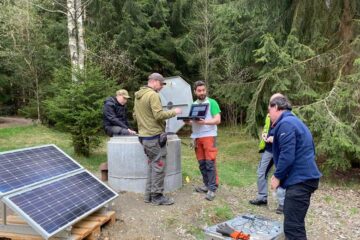Pr Peter E. Nielsen awarded for his works on PNAs, chimera molecules analogues to DNA

The 2001 Jeanne Loubaresse – Institut Curie european prize was delivered the 25th of June 2002 by Pr Claude Hélène during a ceremony taking place at the Institut Curie.
Worth 60 000 euros, it awards Peter E. Nielsen, professor at the Panum Institute (University of Copenhagen, Denmark), „inventor“ of PNAs (Polyamide Nucleic Acids), chimera molecules between genetic material and protein (1) .
PNAs have a dual identity being both a protein and a nucleic acid – having structural properties of DNA and chemical properties of proteins. With these chemical properties, they could penetrate in cells to bind DNA and give interesting perspectives in cancer diagnostic and therapy :
– Very sensitive, these molecules could detect genetic alterations in cell DNA. This is in that case a diagnostic tool helping the research of genetic predisposition to cancer.
– Targeted on a gene, PNAs could modulate its expression. Switch on or off a gene is a good way to correct cellular dysfonctions leading to cancer. PNAs are then therapeutic molecules opening a way towards gene therapy.
The PNAs discovery contribute to the cancer research in a therapeutic and diagnostic way. In the future, these chimera molecules should constitute a significant hope for gene therapy.
The Jeanne Loubaresse – Institut Curie prize
The Jeanne Loubaresse-Institut Curie prize rewards a researcher for a discovery made in Physics, Chemistry, Biology or Medecine that is likely to contribute at short, middle or long term, improvement of cancer prevention, diagnosis or treatement. This discovery must have been made in a public or private research laboratory, located in a country within the European Union, whatever the nationality of its authors.
This prize, awarded every other year during ten years, has been created in 1993 in memory of Mrs Jeanne Loubaresse and according to her testamentary arrangements.
The laureates of the Jeanne Loubaresse – Institut Curie prize
1993 Pierre Potier, Research Director CNRS, member of the French Sciences Academy, for his discovery of new medecine against cancer (navelbine and taxotere).
1995 Anne Dejean-Assémat, Research Director INSERM (Institut Pasteur, Paris) and Laurent Degos, Professor of Hematology (Hôpital Saint-Louis, Paris) to have shown that „all-Trans-Retonoic“ Acid (A vitamin derivative) induces complete remissions in acute promyelocytic leukemia and to have identified the specific alteration of this leukemia.
1997 Jean-Marc Egly, Research Director INSERM (Institut de Génétique et de Biologie Moléculaire et Cellulaire, Strasbourg) to have shown the key role of the transcription factor TFIIH in DNA repair.
1999 No prize awarded.
2001 Selection Comity
President: Claude Hélène, Muséum National d’Histoire Naturelle
Members: Olivier Hyrien, Ecole Normale Supérieure – Claude MalvyI, Institut Gustave-Roussy – Alain Sarasin, Institut de Recherche sur le Cancer – Roger Monier, Institut Gustave-Roussy – Moshé Yaniv, Institut Pasteur – Jean-Pierre Camilleri, Institut Curie – Daniel Louvard, Institut Curie
(1) « Sequence-selective recognition of DNA by strand displacement with a thymine-substituted polyamide » Science, 1991, 254, p.1497-1500.
« PNA hybridizes to complementary oligonucleotides obeying the Watson-Crick hydrogen-bonding rules » Nature, 1993, 365, p. 566-68.
Press Office
Catherine Goupillon – Céline Giustranti
Tel 33 (0)1 44 32 40 63 / 61
service.presse@curie.fr
Iconography
Cécile Charré
Tel 33 (0)1 44 32 40 51
Fax 33 (0)1 44 32 41 67
Media Contact
Alle Nachrichten aus der Kategorie: Förderungen Preise
Neueste Beiträge

Erstmals 6G-Mobilfunk in Alpen getestet
Forschende der Universität Stuttgart erzielen leistungsstärkste Verbindung. Notrufe selbst in entlegenen Gegenden absetzen und dabei hohe Datenmengen in Echtzeit übertragen? Das soll möglich werden mit der sechsten Mobilfunkgeneration – kurz…

Neues Sensornetzwerk registriert ungewöhnliches Schwarmbeben im Vogtland
Das soeben fertig installierte Überwachungsnetz aus seismischen Sensoren in Bohrlöchern zeichnete Tausende Erdbebensignale auf – ein einzigartiger Datensatz zur Erforschung der Ursache von Schwarmbeben. Seit dem 20. März registriert ein…

Bestandsmanagement optimieren
Crateflow ermöglicht präzise KI-basierte Nachfrageprognosen. Eine zentrale Herausforderung für Unternehmen liegt darin, Über- und Unterbestände zu kontrollieren und Lieferketten störungsresistent zu gestalten. Dabei helfen Nachfrage-Prognosen, die Faktoren wie Lagerbestände, Bestellmengen,…





















